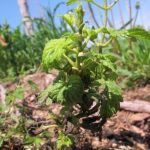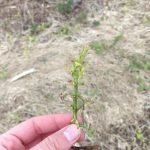
Although the rain is a welcome change from last year, all this moisture indicates that it is prime downy mildew season! Since April 15, we have had 8 days with a high likelihood for infection at the hopyard at Borderview Research Farm in Alburgh, VT, compared to only 2 at this point last year.
Downy mildew is the most persistent hop pathogen in the Northeast and can be difficult to control. Downy mildew sporulates in warm, moist conditions, and can spread very quickly. Plants are most at risk during rainy days because the plant’s stomata, or pores, are open during the day, leaving an open pathway for disease invasion. If there is excess moisture on a hop plant and spores are present, leaves may become infected in as little as 1.5 hours in warm conditions! Shoots may become infected if moisture persists for 3 hours.

Downy mildew is a systemic infection–once your plant has downy mildew, it is infected for life. After the growing season, downy mildew overwinters in the crown of an infected plant. The first sign of infection in spring is the presence of basal spikes. Basal spikes are chlorotic, or yellowing, and have shortened internodes, or the space between leaf pairs. A severely infected basal spike may also have desiccated leaves. It is important to remove all infected spikes and train only health plants. By leaving infected material in your hop yard, you risk infecting healthy plant material.
Basal spikes may be removed using sanitized equipment (clippers or scissors), but sanitization is key! If you’re not taking proper precautions, you run the risk of spreading fungal spores to healthy plants yourself! Basal spikes may also be removed through crowning, a process that mechanically removes the first growth of the season as well the top of the crown. This serves the dual purpose of removing inoculum as well as removing plant material that can be infected.
To help you with scouting downy mildew on basal spikes, we have created a sheet you may use to tracking and documenting downy mildew in your yard: http://www.uvm.edu/extension/cropsoil/wp-content/uploads/Downy_Mildew_Scouting_Basal_Spikes.pdf. For more information, visit our website and/or check out the article, Managing Downy Mildew.
And remember, stay calm and hop on.
